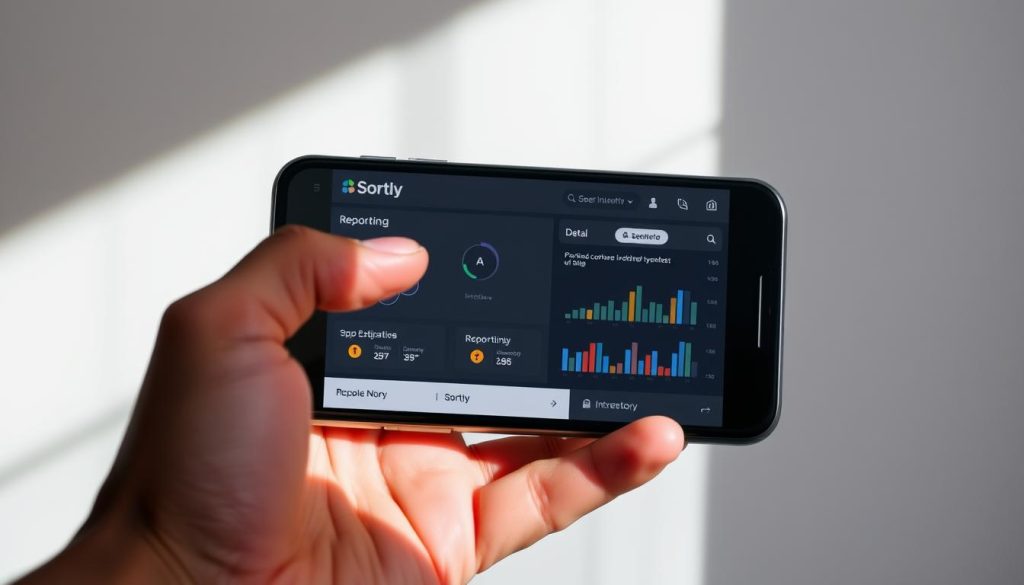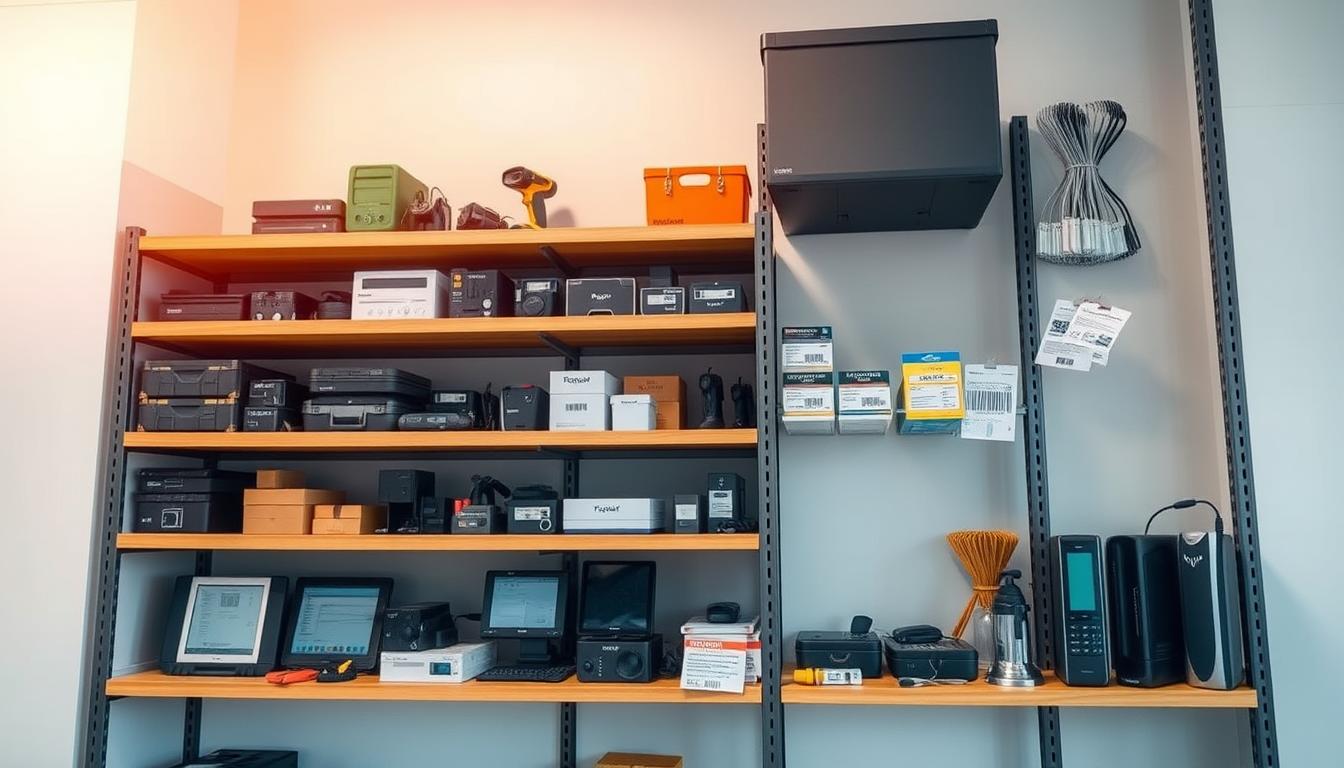Optimize Stock with Top Inventory Management Tools
In the U.S., businesses face challenges such as tight margins, uneven demand, and complex fulfillment processes. This report examines leading inventory management tools and their capabilities to reduce stockouts and cash tied up in inventory. It focuses on practical solutions that improve accuracy, speed, and cost-to-serve.
The analysis draws from 2025 rankings and vendor data, referencing Forbes Advisor Small Business. It assessed 18 companies across 39 decision factors with four levels of fact-checking. The 2025 list includes Ordoro, Katana, Odoo, Finale Inventory, inFlow, ShipMonk, ShipBob, GEP NEXXE, NetSuite ERP, and Sortly.
Forbes reported pricing snapshots, with Finale Inventory at $499 for automated reordering and inFlow near $161 for wholesale and B2B. Sortly offers a free tier then $49, Katana has a free option then $399 billed quarterly, and Odoo has a free community edition and about $38.90 per user for paid plans.
The evaluation focuses on forecasting, inventory optimization, warehouse management, and integrations with various systems. Alaa Amri at Markets Index emphasizes the importance of total cost of ownership and ROI discipline. Research by Sunder Kekre at Carnegie Mellon’s Tepper School shows how demand shifts and supplier coordination impact fill rates and carrying costs.
Vendor materials highlight Sortly’s mobile-first design with in-app barcode and QR scanning, custom fields, photos, low-stock alerts, real-time cloud sync, offline-friendly operation, and exportable PDF or CSV reporting. These features support online inventory management, helping teams move beyond spreadsheets. They improve reorder accuracy and cycle counts while reducing overselling.
The sections that follow compare inventory software by fit and feature depth, then translate findings into actions for procurement, warehousing, and finance. Readers can use this overview to align an inventory control system with service-level targets, working-capital goals, and channel growth plans.
What Makes an Effective Inventory Management System for U.S. Businesses
An effective inventory management system ensures perpetual control, clear audit trails, and fast reconciliation across sales channels. U.S. operators look for platforms that offer real-time accuracy, cost discipline, and scalability. Independent ratings highlight the importance of forecasting, inventory optimization, and warehouse management, weighing these at 29% of the total.
Core capabilities: real-time tracking, inventory optimization, warehouse management
Real-time tracking provides a single source of truth across Shopify, Amazon, and in-store POS. Without central control, small retailers risk showing items as in stock on social feeds while the Shopify catalog is out of stock. A robust inventory control system prevents overselling and cuts cycle count variance.
Inventory optimization tools align reorder points with demand patterns and lead times. Platforms that support perpetual counts, ABC analysis, and dynamic safety stock reduce carrying costs. In warehouse inventory management, bin locations, serial and lot tracking, and multi-location visibility raise pick accuracy and labor productivity.
Integrations that matter: accounting, 3PL, POS, e-commerce, and hardware
Accounting integrations with QuickBooks and Xero eliminate manual reconciliation and close the books faster. Direct links to 3PL partners like ShipBob and ShipMonk support outsourced fulfillment while preserving data fidelity within the inventory management system.
POS, Shopify, and Amazon connectivity synchronizes orders, returns, and adjustments in minutes. Hardware support—barcode scanners, RFID, and scales—accelerates receiving and picking. These integrations convert an inventory control system into a real-time operations hub.
Why forecasting and supplier management drive ROI
Forecasting matches buys to demand, protecting cash during volatile cycles. GEP NEXXE and NetSuite ERP provide advanced modeling that sharpens purchase timing. Under economic uncertainty, targeted product promotion, as recommended by operations scholars such as Sunder Kekre, helps offset shifts and smooths sell-through.
Supplier management capabilities—multi-supplier catalogs, automated purchase orders, and lead-time tracking—support JIT and EOQ goals without pushing excess stock upstream. Finale Inventory and GEP NEXXE are noted for strong supplier tools that pair with inventory optimization tools to maintain service levels and reduce stockouts.
Best Inventory Management Software of 2025: Who Excels and Why
Forbes’ 2025 review ranks leading inventory software using 39 decision factors. Pricing is weighted at 17%, and consumer sentiment at 20%. Vendors with live chat plus phone and email support scored higher on service. This evaluation outlines where each platform leads in modern inventory management solutions. It also highlights which use cases benefit most from these tools.
Ordoro, Katana, and Finale Inventory for robust feature sets
Ordoro, Katana, and Finale Inventory are top choices for SMB to mid-market needs. Katana focuses on warehouse management, serial tracking, and expiration dates for mixed goods portfolios. It offers a free option, with paid plans at $399 billed quarterly.
Finale Inventory emphasizes automated reordering at $499 and adds strong supplier management support. These strengths make both tools practical inventory management solutions for growth-focused brands. They need clear controls, not custom code.
Odoo for budget-conscious teams without sacrificing essentials
Odoo provides a low-cost entry path with a free community edition and paid tiers from about $38.90 per user. Core modules cover purchasing, stock moves, and basic MRP, keeping total cost of ownership in check.
For teams adopting inventory management tools for the first time, Odoo’s modular design reduces upfront risk. It maintains key features expected from mature inventory software.
GEP NEXXE and NetSuite ERP for AI forecasting and full supply chain
GEP NEXXE and NetSuite ERP lead on AI-driven forecasting and end-to-end coordination. NetSuite adds deep traceability across lots and serials, while GEP NEXXE supports supplier collaboration at scale.
These platforms fit enterprises that need unified planning, procurement, and fulfillment in one environment. They turn advanced analytics into actionable inventory management solutions.
inFlow for wholesale/B2B workflows; ShipMonk and ShipBob for 3PL
inFlow, at about $161, targets wholesale and B2B operations with a barcode-first approach and a B2B showroom for easy ordering. It suits distributors that require clear picking and quoting flows.
For outsourced fulfillment, ShipMonk and ShipBob provide 3PL services with custom quotes. ShipBob also advertises Foreign Trade Zones capability, which can reduce duty costs for cross-border goods.
| Platform | Primary Strength | Notable Capabilities | Pricing Snapshot | Best For |
|---|---|---|---|---|
| Katana | Warehouse management focus | Serials, expiration tracking, manufacturing flows | Free option; paid $399 billed quarterly | Brands needing shop-floor control and inventory software with traceability |
| Finale Inventory | Automated reordering | Supplier management, reorder automation, barcode support | From $499 | SMBs scaling replenishment via inventory management solutions |
| Odoo | Low TCO modular suite | Purchasing, stock moves, basic MRP, integrations | Free community; paid from about $38.90/user | Cost-sensitive teams adopting inventory management tools |
| GEP NEXXE | AI demand planning | Supplier collaboration, scenario analysis, procurement | Enterprise, custom | Enterprises needing predictive inventory software across the chain |
| NetSuite ERP | End-to-end ERP with traceability | Lot/serial tracking, financials, multi-entity control | Enterprise, custom | Firms seeking unified ERP and inventory management solutions |
| inFlow | Wholesale/B2B workflows | Barcode-first operations, B2B showroom | About $161 | Distributors and wholesalers needing practical inventory software |
| ShipMonk | 3PL fulfillment | Outsourced warehousing, DTC and B2B shipping | Custom quotes | Brands offloading logistics to inventory management tools plus 3PL |
| ShipBob | 3PL with FTZ capability | Networked fulfillment, Foreign Trade Zones, analytics | Custom quotes | Import-heavy sellers seeking duty savings and reliable inventory software links |
Inventory Management Tools: Matching Features to Business Models
Feature fit is key to achieving high margins and service levels. The right inventory management tools align with the type of product, order model, and sales channels. An effective inventory tracking system, with clear settings, reduces storage costs. It also ensures high fill rates through efficient online inventory management.
Perishables vs. soft goods: expiration dates, serials, and traceability
Perishables demand lot and batch control, first-expire-first-out picking, and recall traceability. Forbes highlights Katana’s support for serial and expiration tracking, while NetSuite ERP is praised for its robust traceability. These features enable quick identification of affected lots during recalls and minimize spoilage.
Soft goods, on the other hand, require variant SKUs, size-color matrices, and kitting. Ensuring inventory sync across Shopify, Amazon, and POS prevents overselling. Mobile scanning in Sortly and inFlow accelerates cycle counts and reduces errors, boosting the accuracy of any inventory tracking system in online inventory management.
JIT, EOQ, perpetual, and MRP support in modern platforms
Platforms should offer JIT to minimize stock levels to current demand, with supplier collaboration to avoid upstream risks. EOQ determines optimal order sizes to balance holding and ordering costs. Perpetual systems update quantities in real time across all sites and channels.
MRP plans materials from confirmed and forecast orders using sales records. Forbes outlines these methods and their objectives. Implementing them in inventory management tools ensures synchronized purchasing, production, and logistics. This synchronization protects service levels and cash flow in an online inventory management setting.
From spreadsheets to systems: when to upgrade
Signs it’s time to move beyond spreadsheets include rapid SKU growth, multi-channel sales, and frequent stockouts or overstock. Manual reconciliation time and error rates become significant costs as order volume increases. Centralized controls within an inventory tracking system prevent double-selling across Shopify and social channels.
Teams benefit from barcoding, role-based workflows, and audit trails that spreadsheets lack. Sortly and inFlow introduce mobile-first scanning and real-time reporting, shortening count cycles and improving data accuracy. These advancements illustrate how online inventory management grows with disciplined processes and stable integrations.
Top Picks and Pricing Snapshots to Guide Your Shortlist
These pricing snapshots compare leading inventory software by cost and core capability. Each pick supports an inventory tracking system for modern operations. They align with practical inventory management solutions used by U.S. businesses.
The figures reference publicly listed plans and widely cited market positioning. They highlight automation, barcode workflows, and warehouse control. These support purchasing, sales, and fulfillment.
| Platform | Starting Price | Positioning | Key Capabilities | Best For |
|---|---|---|---|---|
| Finale Inventory | From $499 | Automated reordering with supplier tools | Reorder automation; demand rules; barcode receive/pick | Firms needing a scalable inventory tracking system |
| inFlow | About $161 | Wholesale and B2B workflows | Barcode operations; B2B showroom; quotes to invoices | Distributors requiring practical inventory management solutions |
| Sortly | Free tier; paid from $49 | Mobile-first inventory management | In-app barcode/QR; custom fields; photos; low-stock alerts; PDF/CSV exports | Teams prioritizing simple, portable inventory software |
| Katana | Free entry; paid options (e.g., $399 billed quarterly) | Warehouse management and traceability | Serials; expiration dates; routing; shop-floor control | Manufacturers seeking structured inventory tracking system controls |
| Odoo | Free community; paid from about $38.90/user | Low-cost entry without losing essentials | Modular apps; WMS; accounting; POS; purchase | Cost-focused firms deploying modular inventory management solutions |
| ShipBob | Custom quote | 3PL with value-added services | Nationwide fulfillment; FTZ support; returns | Brands outsourcing logistics while retaining inventory software visibility |
| ShipMonk | Custom quote | 3PL for DTC and omnichannel | Pick/pack; kitting; marketplace connectivity | Growth-stage sellers needing external warehousing and an integrated inventory tracking system |
Free tiers and transparent pricing improve trial speed and reduce evaluation costs. Forbes-weighted scoring has highlighted pricing availability, free trials, and lower monthly spend as meaningful selection factors.
When building a shortlist, align contract terms and feature depth with forecast accuracy, supplier coordination, and barcode discipline. This ensures the chosen inventory software and inventory management solutions support both current throughput and future channel growth.
Warehouse Inventory Management and Online Inventory Management Essentials
Effective inventory control systems significantly reduce handling time and error rates. By integrating barcode/RFID, bin-level tracking, and omnichannel data, pick speed and stock accuracy improve. Warehouse inventory management is enhanced by pairing these tools with accounting and 3PL integrations. This streamlines purchase orders and receipts.
Bin locations, barcode/RFID, and multi-location control
Bin locations and zone mapping enhance pick accuracy and reduce travel paths. Barcode scanners and RFID readers facilitate quick product identification and cycle counts. Sortly offers in-app barcode and QR scanning, high-resolution photos, custom fields, and low-stock alerts for audits.
Multi-location control synchronizes stock across various sites. A unified inventory control system enables teams to set directed putaway, track SKUs at the bin level, and automate replenishment between sites.
Omnichannel sync across Shopify, Amazon, POS, and marketplaces
Real-time synchronization prevents overselling and backorders. Online inventory management should update quantities immediately after orders post on Shopify, Amazon, and POS. Centralized listings and SKU mapping ensure consistent availability and pricing.
When orders close, allocations adjust on every channel. This preserves margin, stabilizes service levels, and feeds accurate data to forecasting and purchasing workflows.
3PL coordination with ShipBob and ShipMonk
ShipBob and ShipMonk offer nationwide fulfillment with custom pricing and integrations. A connected inventory control system transmits ASNs, routes orders by SLA, and reconciles receipts to POs. ShipBob also promotes Foreign Trade Zones benefits for duty deferral on qualified imports.
Coordinated dashboards show stock on hand, in transit, and allocated across 3PL nodes. This visibility supports warehouse inventory management for both owned sites and outsourced facilities.
| Capability | Operational Benefit | Key Tools and Brands | Where It Applies |
|---|---|---|---|
| Bin-level tracking | Higher pick accuracy; faster replenishment | Directed putaway; location IDs | Distribution centers; retail backrooms |
| Barcode/RFID identification | Lower scan errors; quicker counts | Handheld scanners; RFID portals | Receiving docks; cycle counts |
| Omnichannel sync | Reduced oversell risk; consistent stock | Shopify, Amazon, POS integrations | E-commerce and store operations |
| Mobile scanning and alerts | Faster audits; proactive replenishment | Sortly in-app barcode/QR; low-stock alerts | On-floor checks; audit cycles |
| 3PL order orchestration | On-time fulfillment; cost control | ShipBob, ShipMonk; ASN and PO sync | Outsourced fulfillment networks |
| Accounting integration | Clean receipts; automated POs | Purchase orders; multi-supplier management | Procurement and finance |
Aligning warehouse inventory management with online inventory management ensures every movement is captured once and applied everywhere. This results in dependable data for staffing, slotting, and purchasing decisions across the entire inventory control system.
Deep Dive: Sortly’s Mobile Inventory Management and Real-Time Reporting
Sortly transforms phones into essential inventory management tools. Its software supports quick setup by importing existing lists and organizing items. It’s perfect for teams managing inventory across multiple locations, balancing speed with accuracy.

In-app barcode/QR scanning and offline-friendly mobile app
The app allows for quick barcode and QR code scanning, speeding up counts and transfers. Teams can scan items even without internet, with offline capture storing entries until synced. This keeps inventory movements consistent across sites.
This method cuts down on manual input and reduces shrinkage risk. It ensures a clear chain of custody. It’s a key feature of modern inventory management tools, supporting fast field work and aligning with various workflows.
Custom fields, photos, and low-stock alerts for smarter control
Users can add custom fields for SKU, warranty date, unit cost, or department code. High-resolution photos provide visual identification, speeding up picks and checks. Low-stock alerts notify staff before stockouts, enabling timely purchase orders and tighter control over working capital.
These features make the software adaptable to different types of inventory. Clear thresholds and visual cues help managers prioritize tasks and maintain accurate valuation.
Cloud sync across devices with exportable PDF/CSV reports
Cloud synchronization updates data across mobile, desktop, and tablet in real time. Activity logs track item-, folder-, and user-level histories, aiding audits and budgeting. Reports export to PDF and CSV for reviews, board packets, or ERP uploads.
This shared source of truth supports remote teams and multi-site operations. A free tier and paid plans starting at $49, plus a 14-day trial, offer a low-risk path to scale.
| Capability | Operational Benefit | Use Case | Data Output |
|---|---|---|---|
| In-app barcode/QR scanning | Faster receiving and cycle counts; fewer errors | Warehouse intake, field audits, asset tagging | Timestamped scans, user attribution |
| Offline-friendly mobile app | Uninterrupted data capture without connectivity | Job sites, remote storage, retail backrooms | Queued transactions auto-synced |
| Custom fields and photos | Richer item profiles and faster identification | Serial tracking, warranty control, visual picks | Structured metadata, image records |
| Low-stock alerts | Proactive replenishment and fewer stockouts | Reorder management for fast movers | Threshold-triggered notifications |
| Cloud sync | Real-time visibility across teams and locations | Multi-site coordination and approvals | Unified item histories and access logs |
| PDF/CSV reporting | Audit-ready exports and financial reviews | Budgeting, forecasting, compliance checks | Item-, folder-, and user-level reports |
Small Business Inventory Management Solutions That Scale
Small businesses benefit from inventory management systems that offer low costs and automation. These systems help avoid stockouts and overstock. They should support barcode scans, create purchase orders, and sync across multiple channels easily. As orders increase, scalable solutions prevent manual delays and protect cash flow.
inFlow streamlines barcode workflows, supports B2B ordering, and has simple setup. Sortly offers mobile-first control with in-app scanning and fast reporting. It allows for gradual expansion as SKUs and channels grow. Zoho Inventory targets budget-conscious teams with batch and serial tracking, automated reorder notices, and built-in shipping tools. It also offers a free plan for small volumes.
Square for Retail provides a free plan tied to POS, with barcode scanning and low-stock alerts. This helps staff respond quickly. Lightspeed Retail adds multi-location oversight and advanced reporting for growing stores. QuickBooks Commerce integrates real-time stock with QuickBooks accounting for unified sales and finance records.
EasyReplenish focuses on SMB needs with AI forecasting, dynamic reorder points, and multi-channel synchronization. These features improve service levels and reduce excess working capital. A well-chosen inventory tracking system reduces manual counts, stabilizes lead times, and supports accurate reorder timing.
Free options like Square’s free tier, Odoo Community, or basic Excel templates suit small, single-channel operations. As volume grows, paid solutions with forecasting and automation can save by reducing stockouts and labor hours. For teams aiming to grow, choosing a platform that aligns with growth milestones ensures it remains a valuable asset.
Forecasting and Inventory Optimization Tools That Protect Cash Flow
Forecasting accuracy is key to managing working capital, service levels, and cash reserves. A modern inventory management system translates demand into optimal buys, controlling costs. The right tools balance speed, margin, and risk across all channels.
AI-driven demand planning in GEP NEXXE and NetSuite ERP
Forbes highlights GEP NEXXE and NetSuite ERP for their AI-backed forecasting. These platforms use AI to predict demand based on seasonality, promotions, and volatility. NetSuite also focuses on traceability, aiding in regulated goods and recall readiness.
AI models reflect changes in consumer behavior, as noted by Sunder Kekre. Under uncertainty, buyers tend to delay or opt for cheaper alternatives. Inventory management tools that track real-time sales and returns help target promotions and adjust inventory before it’s too late.
Dynamic reorder points and automated purchase orders
Dynamic reorder points adjust to demand and supplier lead times. Finale Inventory offers automated reordering starting at $499, supporting multi-supplier logic and automated purchase orders. Forbes ranks this as a key secondary capability, reducing manual work and aligning orders with market pace.
Automated replenishment engines like EasyReplenish convert forecasts into timed POs across channels. When integrated into inventory optimization tools, buyers can assess lead-time reliability, landed cost, and MOQ constraints without leaving the dashboard.
Reducing stockouts and overstock with data-driven decisions
Data-driven practices use real-time sales data from Shopify, Amazon, and POS, along with vendor lead-time performance and lot or serial visibility. Perishables have lower safety stock with tighter rotations, while soft goods receive right-sized buys and markdown timing. Sortly supports exports for budgeting and demand analysis, and inFlow’s reporting and B2B showroom help wholesalers anticipate order cadence.
With integrated inventory management tools, planners reduce stockouts and aged stock by synchronizing forecasts, replenishment, and warehouse execution. An inventory management system that unifies forecasting with purchasing policy protects cash flow by matching inventory to verified demand signals.
How to Choose an Inventory Tracking System: Criteria and Trade-Offs
Choosing an inventory tracking system begins with a thorough needs and cost assessment. Alaa Amri suggests that teams first identify their pain points and set clear goals. They should then quantify the total cost of ownership. It’s essential to evaluate the system’s capabilities, the inventory control policies it supports, and any software dependencies before narrowing down vendors.
Budget versus capability: when paying more saves more
Forbes’ scoring places a 17% weight on pricing, highlighting the importance of transparent pricing tiers and free trials. While upfront costs may seem lower, manual tasks can negate these savings. Investing in a higher-tier inventory software can lead to significant cost savings, reduced stockouts, and lower labor costs.
- Free or low-cost tiers: Square free, Odoo Community, and Zoho free cater to micro-sellers but limit automation and forecasting.
- Growth paths: Katana and Finale Inventory offer MRP, multi-warehouse, and automated reorders for businesses scaling up.
- Enterprise depth: NetSuite ERP and GEP NEXXE provide AI demand planning and supplier collaboration, mitigating risks.
Ease of use and adoption: mobile-first, dashboards, and training
Adoption is key to realizing ROI. Intuitive dashboards, clear workflows, and mobile access facilitate quick onboarding. inFlow is praised for its simple barcode flows. Sortly supports in-app scanning, offline work, fast setup, and cloud sync.
- Mobile scanning and labels reduce errors on the floor.
- Role-based views focus users on tasks and KPIs that matter.
- Training and support shorten the learning curve across sites.
Integrations and future-proofing for growing catalogs and channels
Integration breadth is critical for future-proofing an inventory control system. Link accounting via QuickBooks and QuickBooks Commerce. Coordinate 3PLs such as ShipBob and ShipMonk. Sync POS like Square and Lightspeed, and e-commerce with Shopify, Amazon, and eBay.
- Hardware readiness: barcode scanners and RFID improve traceability.
- Industry fit: lot and expiration for food and beverage; variant management for apparel; B2B portals for wholesalers.
- Scalability: as channels expand, the inventory tracking system and inventory software should sustain higher order volume and more SKUs without rework.
Conclusion
U.S. teams can now select inventory management tools based on their specific needs. Mobile-first options like Sortly, inFlow, Zoho, and Square offer quick setup and fast accuracy gains. Mid-market platforms, including Katana, Finale Inventory, and Ordoro, provide automated reordering and multi-supplier control.
These platforms also track serial and expiration dates and offer stronger warehouse controls. For a deeper supply chain integration, GEP NEXXE and NetSuite ERP use AI for forecasting and provide end-to-end traceability. This includes traceability across procurement, production, and fulfillment.
Forbes’ 2025 assessment emphasizes three key areas: forecasting, inventory optimization, and warehouse management. Systems that integrate with various platforms raise data quality and reduce cycle times. Pricing varies from free community editions to $49–$161 entry plans, and up to $399 and $499 tiers, with custom quotes for enterprise suites.
Transitioning from spreadsheets prevents overselling, reduces manual reconciliation, and enhances cash flow. Execution is critical. Sortly’s mobile scanning and reporting enable field teams to count accurately. inFlow streamlines wholesale and B2B workflows.
ShipBob and ShipMonk offer 3PL services for national coverage. Align the chosen platform with your business model and inventory management methods. Strong supplier collaboration and data-driven planning protect service levels and free up working capital.
Opt for inventory management tools that balance cost with control, scaling features as needed. Effective warehouse and online inventory management keep stock levels visible, automate reorders, and synchronize channels. This approach minimizes stockouts, lowers carrying costs, and ensures a resilient operation ready for demand changes.
FAQ
What defines an effective inventory management system for U.S. businesses?
An effective system tracks inventory in real-time and optimizes stock levels. It manages warehouses efficiently, supports detailed tracking, and controls inventory across multiple locations. It also automates inventory counts. Top platforms integrate with various systems, including accounting and e-commerce, to prevent stockouts and improve cash flow.
Which inventory software ranked well in 2025 evaluations and why?
Forbes Advisor’s 2025 list includes Ordoro, Katana, Odoo, Finale Inventory, and others. The evaluation considered 39 factors, focusing on forecasting, inventory optimization, and warehouse management. Katana and Finale Inventory excel in warehouse management and automated ordering. GEP NEXXE and NetSuite ERP lead in AI forecasting and traceability. Sortly and inFlow offer mobile solutions at affordable prices.
When should a company move from spreadsheets to an inventory tracking system?
Upgrade when selling across multiple channels creates data discrepancies. This is evident when SKU counts increase or stockouts and overstock become common. Dedicated systems reduce errors, automate orders, and provide real-time visibility, supporting just-in-time and economic order quantity strategies.
How do forecasting and supplier management improve ROI?
AI-driven demand planning optimizes inventory levels, reducing excess stock and costs. Dynamic reorder points and automated POs adapt to changing demand. Experts recommend focusing on high-demand products and evaluating total costs to maximize ROI. Platforms like GEP NEXXE and NetSuite ERP offer robust forecasting and supplier collaboration.
What pricing benchmarks help compare inventory management solutions?
Public pricing in 2025 shows Finale Inventory at 9 for automated reordering. inFlow costs about 1 for wholesale/B2B. Sortly offers a free tier then , while Katana starts at 9 quarterly. Odoo has a free community edition and paid plans around .90 per user. ShipBob and ShipMonk provide custom quotes for 3PL services. Clear pricing and free trials are key to high scores in the Forbes framework.
Which tools fit perishables versus soft goods?
For perishables, focus on lot/batch tracking, expiration dates, and recall traceability. Katana and NetSuite ERP excel in these areas. Soft goods require variant SKUs, bundling, and omnichannel sync to prevent overselling. Ensure the system supports just-in-time and economic order quantity replenishment models.
What integrations are most valuable for scalable inventory management?
Key integrations include accounting suites, 3PLs, POS systems, e-commerce platforms, and hardware like barcode scanners. These connections reduce manual work, streamline receipt and order management, and centralize data for accurate forecasting.







